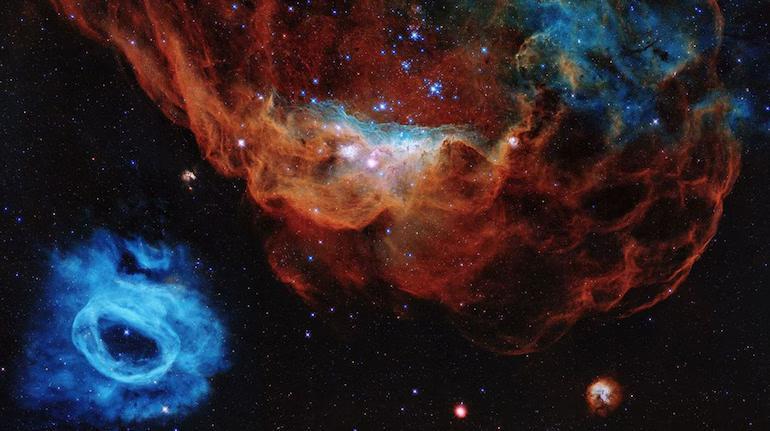
Cosmic Reef: NASA’s Hubble Shares Image of Galaxies Shaped Like an Alien Ocean
The wonders of the universe never cease to amaze us. NASA’s Hubble Space Telescope has once again thrilled us with its latest image of the “Cosmic Reef”. This stunning picture captures a giant red nebula and a smaller blue neighbour, both of which are part of a star-forming region in the Large Magellanic Cloud. The image is a perfect representation of the term “cosmic reef”, with the galaxy shapes resembling coral from an alien ocean.
The Large Magellanic Cloud is a satellite galaxy of the Milky Way, located approximately 160,000 light-years away from us. It is a popular target for astronomers due to its proximity and the variety of celestial objects it contains. The Cosmic Reef is just one of the many fascinating regions in this galaxy, and Hubble’s image is a testament to the incredible capabilities of this space telescope.
Since its launch in 1990, Hubble has studied nearly 47,000 celestial objects, including stars, galaxies, and other cosmic phenomena. The telescope has been instrumental in expanding our understanding of the universe, and its images have captivated the imagination of people around the world.
The Cosmic Reef image is a result of Hubble’s Advanced Camera for Surveys (ACS) and the Wide Field Camera 3 (WFC3), which are designed to capture high-resolution images of the universe. The ACS is capable of resolving objects as small as 10-20 light-years across, while the WFC3 can capture images of objects as large as 100,000 light-years across.
The image of the Cosmic Reef shows a giant red nebula, which is a massive cloud of gas and dust that is illuminated by the intense radiation from nearby stars. The nebula is shaped like a coral reef, with tendrils of gas and dust stretching out in all directions. The blue neighbour, on the other hand, is a smaller star-forming region that is surrounded by a halo of gas and dust.
The Cosmic Reef is an ideal location for studying the formation of stars and galaxies. The region is home to a number of young, hot stars that are responsible for the intense radiation that illuminates the nebula. The stars are embedded in the gas and dust of the nebula, and they are the primary source of energy for the region.
The image of the Cosmic Reef also provides a unique opportunity for astronomers to study the properties of the gas and dust in the region. The gas and dust are the raw materials from which stars and galaxies are formed, and understanding their properties is crucial for understanding the formation and evolution of the universe.
The Cosmic Reef image is just one of many incredible images captured by Hubble over the years. The telescope has been used to study a wide range of celestial objects, from the nearest planets in our solar system to distant galaxies billions of light-years away.
In conclusion, the Cosmic Reef image is a stunning representation of the wonders of the universe. The image shows galaxies shaped like an alien ocean, with giant red nebulae and smaller blue neighbours that are part of a star-forming region in the Large Magellanic Cloud. The image is a testament to the incredible capabilities of NASA’s Hubble Space Telescope and its ability to capture high-resolution images of the universe.






